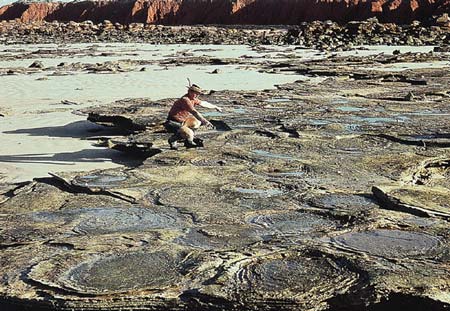
This Article From Issue
May-June 1999
Volume 87, Number 3
DOI: 10.1511/1999.24.0
Dinosaurs of Australia and New Zealand and Other Animals of the Mesozoic Era. John A. Long. 188 pp. Harvard University Press, 1998. $39.95.
The Southern Hemisphere was a very interesting place in the Mesozoic Era, but its fossil record has been slow in making a debut in the popular literature. There are several reasons for this. The sundered supercontinent of Gondwana now lies scattered across the southern seas in widely separated fragments of its former glory. For much of this century, paleontology in the Southern Hemisphere was practiced provincially, and the results rarely saw the light of day in the Northern Hemisphere. This is a sad thing indeed, for the ancient ecologies of Gondwana are utterly fascinating and offer a wonderful antidote to perceptions fostered mainly on the biota of the north. In recent years dinomania has trickled south, and the result has been a burst of research, discoveries and popular literature. Spectacular recent dinosaur discoveries in Patagonia, Antarctica, Madagascar, India, Australia and New Zealand have begun to flesh out the story of the Mesozoic of Gondwana.

From Dinosaurs.
This contribution by John A. Long is an amply illustrated and beautifully designed introduction to the Mesozoic vertebrate fauna of Australia and New Zealand. The pretty pictures temporarily conceal the fact that this book is an odd hybrid between a popular primer on dinosaurs and a somewhat dry catalogue of every scrap of Mesozoic bone collected down under. This paradox doesn't disturb me, nor does it really detract from the usefulness of the book. In fact, it makes the book fun to look at and informative in an unusual way. For specialists, pictures of fragments aid in understanding the basis and validity of taxonomic determinations for a region that many may not have visited. For others, this is an amazingly graphic illustration of the fragmentary nature of the fossil record and an exhortation to keep looking for new sites and specimens. Many of the significant fossils in the book were found and collected by amateurs, and Long recognizes and encourages these contributions to our growing knowledge.
The book contains plenty of attractive reconstructions of ancient ecosystems and scenic shots of excavation sites to keep the pages turning despite the heavy load of jargon-laden descriptions of obscure amphibian fragments. Yes, amphibians! The publisher's marketing department has clearly realized the ability of the word "dinosaur" to sell books. Fortunately, Long has ignored the emphasis of his title and included the entire vertebrate fauna of the Mesozoic, and the book is much the better for it. For this reason, however, Long's book covers much of the same material that appeared in Wildlife of Gondwana, an equally well-illustrated and more broadly based 1993 book by Tom Rich and Pat Vickers-Rich that was not distributed beyond Australia. Long does give ample credit to them for their tireless pursuit of Australian dinosaurs and to Joan Whiffen, the amateur to whom New Zealand owes the discovery of all of its dinosaurs. Long's book promises dinosaurs of Australia and New Zealand and other animals of the Mesozoic Era. I hope it is also a harbinger of similar contributions from the other fragments of Gondwana.—Kirk R. Johnson, Denver Museum of Natural History
American Scientist Comments and Discussion
To discuss our articles or comment on them, please share them and tag American Scientist on social media platforms. Here are links to our profiles on Twitter, Facebook, and LinkedIn.
If we re-share your post, we will moderate comments/discussion following our comments policy.